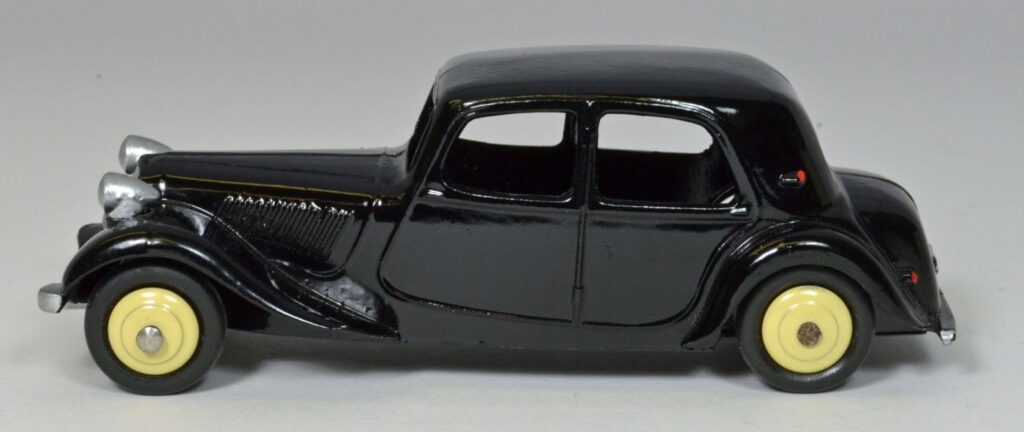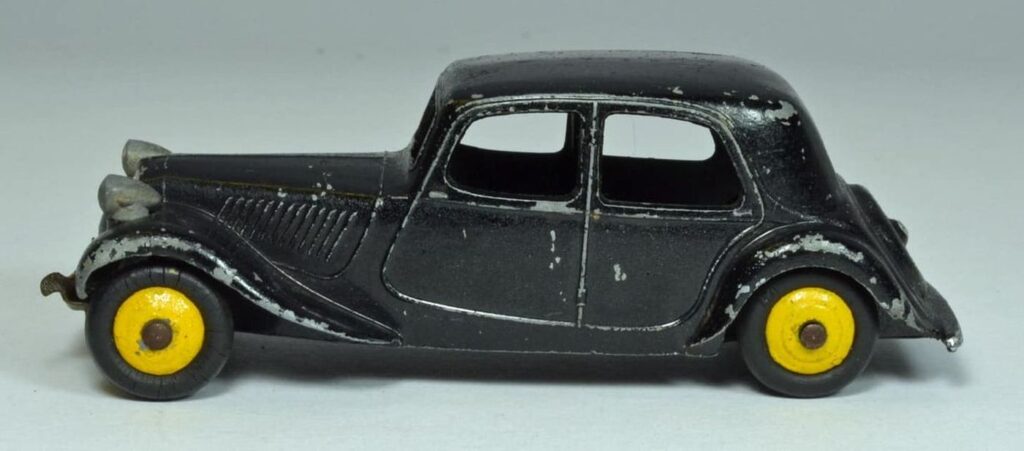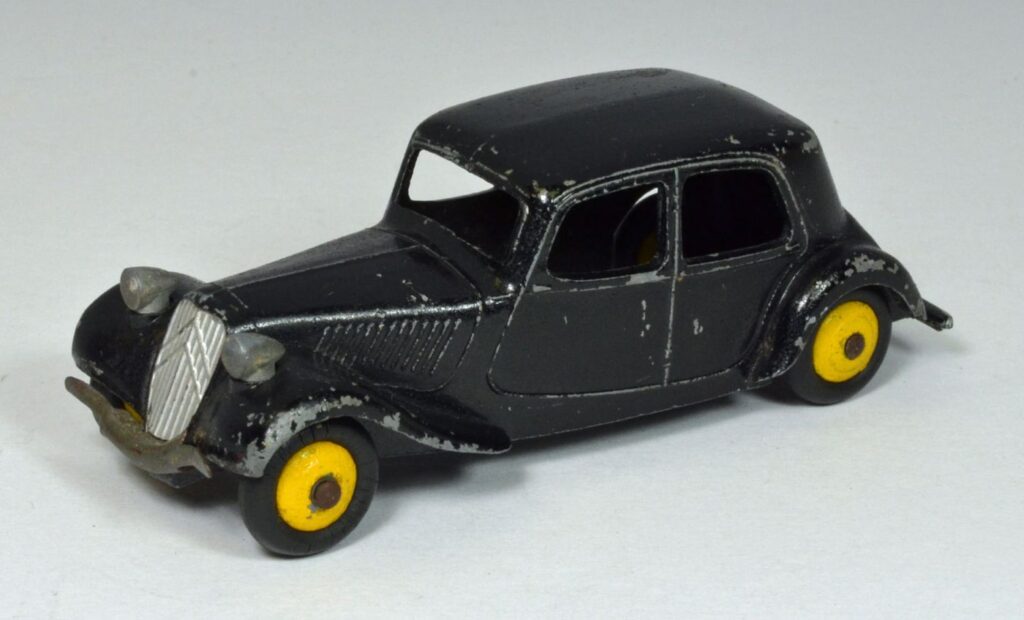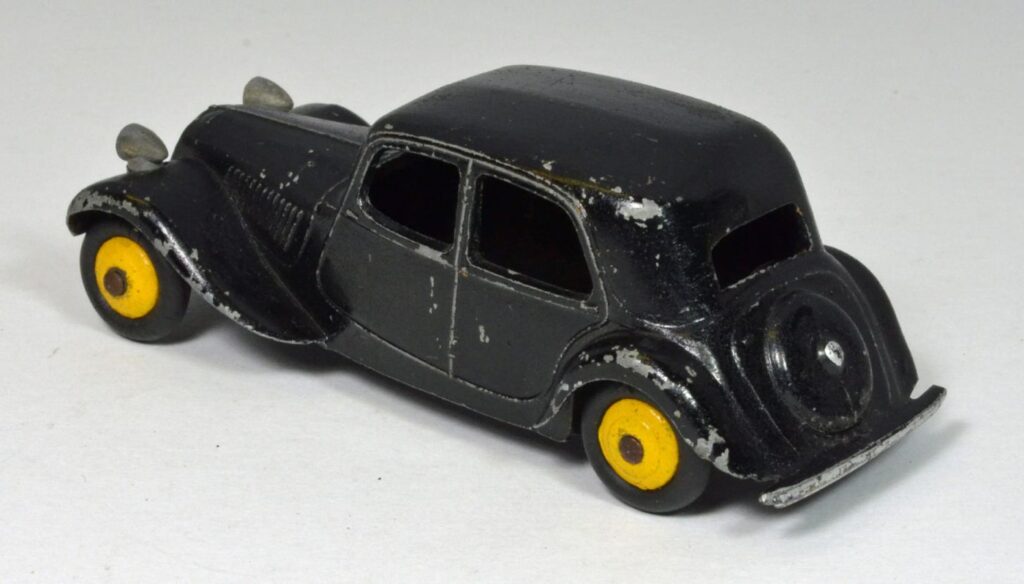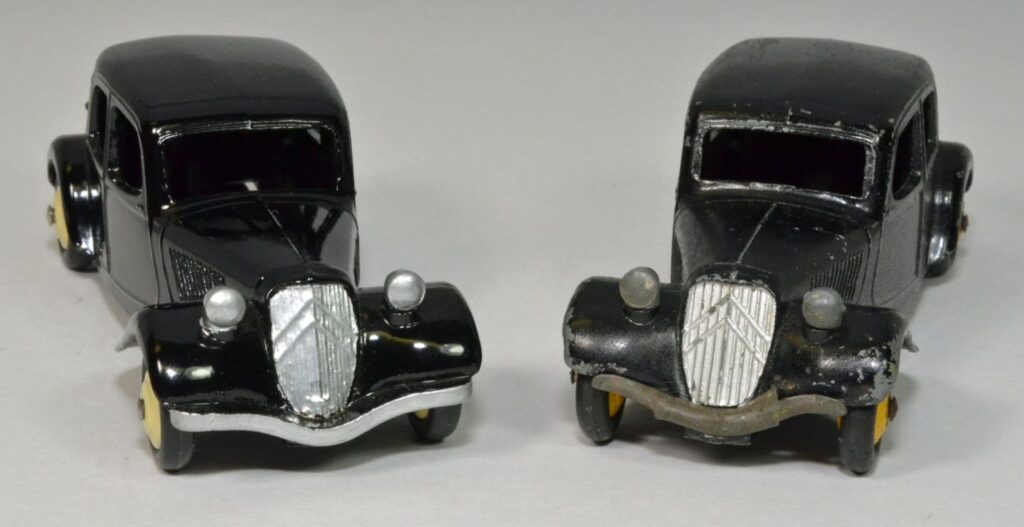My very first French Dinky Toy was this 24N Citroen 11BL Traction Avant. It wasn’t easy buying it, as I saw it in a local toy store in Southern California, in 1956, and I wanted it right away, but this black beauty was the only one they had left, and it was securely mounted in place on one of those old tiered wooden displays. I asked about buying it off of the display, but they declined, saying it was firmly attached and would be damaged.
I went home and thought about it. I was only 11 years old at the time, and decided I would offer them a plan: I would bring along my dad’s pliers and screwdriver, and offer to remove it myself, and pay the listed price. They agreed to that, and after some fussing, I had my model, albeit with some slight damage due to it being wired down to the display, but I was very happy, as I loved this black Citroen.
Over many years, it became a bit scratched up, so many years ago I treated it to a professional restoration, which turned out quite nice. Unfortunately, the restorer decided to paint those headlight shells silver instead of leaving them plain cast finish, as was original. But no matter, I still love it, and it is a most handsome model in glossy black, and it’s a dear piece from my early Dinky collecting days.
Fortunately, that toy store was really a bookstore in downtown Santa Ana, Ca, that had a basement where they sold the Dinky’s. As a youngster, I frequented them often enough that they got to know me. One of the sales ladies would even let me come behind the counter, open the door to the storage cabinet, and look through their stock of new Dinky’s. I still have my 1953 Dinky Toys catalog from that store. So that store and that model have a great sentimental value to me.

A few years ago, I purchased one of the early, first versions of the Citroen 11BL , in just average condition. This shows the rear boot or trunk area with the raised holder for the spare tire.
Here are some comparison photos, one showing the different rear boot or trunk areas.
And here is my slightly later grey version: this was the last version made of the Citroen, from the late 1950’s. I bought this one new in 1959, in San Diego. I spotted this one that I had never seen before, and immediately liked it. It was the last version they made, in grey, and I bought it right away, and was also rewarded with the then empty trade box it came in. So I have had this little gem 62 years now, and I still love it, and the French Meccano folks made a lovely casting of it.

Baseplates
One thing that caught my eye in those early days was the baseplates on Dinky cars: they had an interesting finish. Besides the neat stamped lettering on them, they had a curious finish I had never seen before. It looked slightly streaked with lighter strands scattered across a darker background. Years later I learned more about this finish, and also noticed they quit using it around 1957 or so, when they went to a glossy black finish, followed a few years later by a flat black finish.
I did some research and found out that the early mottled/streaky looking finish was called Brunofix, and was a type of blueing applied to metal to provide a protective finish that would resist rusting. Both the English and French factories used this, and it’s impossible to duplicate, so if someone disassembles a Dinky model to refinish it, they often also re-paint the baseplates… which will usually be some form of black paint. So inspecting the baseplate is one quick way to determine if a Dinky model has been re-finished and no longer original.
The image below shows one of these Citroen 11BL baseplates in good detail from my grey version, along with another rear trunk comparison.
Some Historical Background
The real Citroen Traction Avant was designed and introduced in Paris in 1934 and remained in production a very long time, with occasional small changes, being produced again after WWII. In 1949, the French Meccano factory was eager to produce some all-new models, so this famous Citroen 11BL was launched by them in 1949 as well.
In 1952, the Citroen folks made some design changes: the major one being to enlarge the rear boot, or trunk, and place the spare tire inside of it. Dinky apparently knew of this design change pretty early and decided they needed to stay current, so they recreated this most successful model. In doing so, they decided it best to design and make an all-new die.
This new die looks very much like the original, but upon close inspection one will see they not only added the enlarged rear boot, but they also did away with the awkward tinplate bumper, now using diecast, and they also took the time and effort to redesign the front radiator grill, adding more and narrower slats, and also the louvers on each side of the engine compartment were made much small and more numerous, more like the real car.
This new, revised Dinky model was launched in 1953, but used the same model number, 24N. In its new form, this model remained in the French Dinky Toys lineup until the late 1950’s, with colors being mostly black, with grey being used in later models. This model never appeared in a separate yellow box, but was always in trade boxes of six.
Very early on I noticed some of the subtle differences between the French and English Dinkys, but it wasn’t until years later that I learned more about them. However, I did know that I really loved this shiny black French sedan. After 68 years of ownership and being restored, I still love it.
